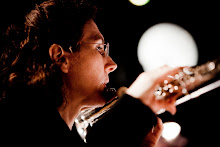Thank goodness for imagery. Here is a collection of ideas to help stimulate the aural imagination. I was inspired by Photo Shop's gradient tool to make the following images.
Let's take one note and see what kind of spectrum can be produced. I chose B natural because it is the Moyse thing to do, but choose a note that is good for you. The purpose is to take a full breath, play a single note while going from one aural extreme to another. What happens in the middle can be quite interesting, I find. You can also practice these exercises backwards.
Some people work well with color imagery, so an exercise like this might work:
 Another exercise could be to imagine a trumpet-like sound, then go to the extreme of complete air noise. I thank Harrie Starreveld for this suggestion.
Another exercise could be to imagine a trumpet-like sound, then go to the extreme of complete air noise. I thank Harrie Starreveld for this suggestion.You can also consciously control the position of your tongue by producing different vowel sounds. For example thinking a deep, open O sound, to a rather closed I (think of the word "eye"). I spelled it "aye" in the example. In preparation for this, I like to sing the exercise first to get a feel for how the tongue moves and how it changes the harmonic components of the sound.
Peter Lukas Graf also has an interesting approach. He describes different categories of sounds starting with those that are rich in overtones, think of the opening of the second movement of Cesar Franck's Sonata in A, to those that are poor in overtones, think of the opening of Debussy's L'Apres Midi. Of course it is a simplification, the music of Franck and Debussy require a variety of colors, but these are the associations that stick. If such imagery is useful, here is an illustration:





I prefer the term "shade of color" rather than just "color," because I think each note has its own unique color, or sound wave frequency, and our choice is how to shade it (light to dark, diffuse to intense, etc.), the same way actual colors (light wave frequencies) have different shades (light to dark red, blue, green, etc.). I also like to specifically refer to the effects of aperture size and shape and different blowing angles as the main variables that affect these shades. Your approach is more conceptual, which may be the way some people learn best, but some, like me, are the more "meat and potatoes" type who need detailed physical descriptions. Thanks for posting about this.
ReplyDeleteThank you Rick, I have also had feedback on the question of shades of dynamics, too. I left out the question of dynamics, leaving that up to the player to explore.
ReplyDeleteI understand your needing more physical description, too. It has has been very helpful to me in the past if someone just hints about the tongue position or the angle of the air.
Here are some useful sources of information on the subject brought to my attention by Jennifer Cluff:
ReplyDeleteFor Novice to Intermediate Students: Tone Development:
Tone Warmups 17 pages - (free pdfs for students to print)
http://jennifercluff.blogspot.com/2012/02/2-higher-longtone-warmups-free-pdfs.html
________________
Flute Tone Colour Exercises for Intermediate to Advanced Students - Books:
De La Sonorite by Marcel Moyse
(See: Fullness of Tone exercise)
Tone Development Through Extended Technique by Robert Dick
(See: Singing while playing and vowel sounds used in playing registers)
Playing in Colour: Improving Tone for Advanced Players by Ann Cherry
(This describes tone colour experiments very colourfully).
The Art of Playing the Flute by Roger Mather (Volumes 1-3)
(Much on developing various tone colours and using them in performance.)
_______________
For more titles and direct links to the above flutes to see covers, go to:
http://jennifercluff.com/reading.htm